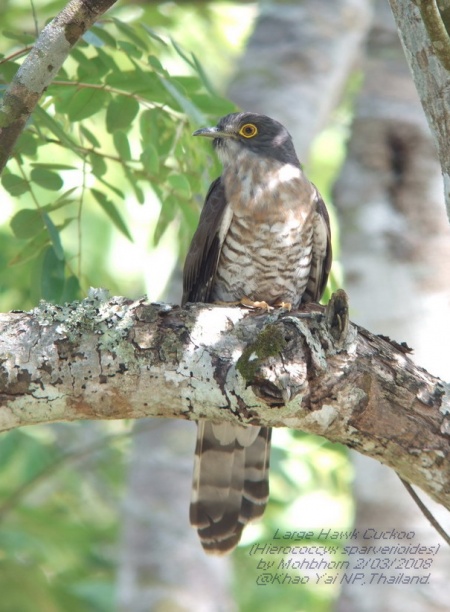Alternative name: Brain-fever Bird
- Hierococcyx sparverioides
Identification
38-40 cm.
- Brown above
- Ashy-grey crown, nape and neck
- Brownish grey and black barred tail
- Black chin, white throat and rufous breast, throat and breast dark-streaked
- White belly with blackish bars
- Yellow eye-ring
Juveniles have barred rufous and brown upperparts, a grey forehead, a white nape, a rufous and black barred tail and have buff underparts streaked with black teardrops.
Distribution

Photo by Alok Tewari
Sultanpur National Park, India, January-2011
Breeds in the Himalayas from northern Pakistan and India to Nepal and China (Sichuan and lower Yangtze valley), south to Burma, Thailand and Indochina.
Winters from southern India and Bangladesh to Thailand, Malaysia, Singapore, the Greater Sundas and to the Philippines.
Common to fairly common in its range, scarce in Singapore.
Taxonomy
This is a monotypic species.
Formerly considered conspecific with Dark Hawk-Cuckoo.
Has formerly been placed in the genus Cuculus.
Habitat
Found in deciduous and evergreen forests and open forest. On passage and in winter also in mangroves and gardens.
Occurs at 900-2700m in India during breeding season, up to 3000m in Nepal.
Behaviour
Diet
Feeds on insects, mainly caterpillars. Takes also berries.
Forages in the canopy, mainly solitary.
Breeding
Breeding season June to July in the western Himalayas, April to June in Assam. A brood parasitic. Known host species are Laughingthrushes, Streaked Spiderhunter, Lesser Shortwing and Chestnut-capped Laughingthrush. Places one egg in hosts nest.
Vocalisation
Both recordings © by Alok Tewari
Calling in a high valley in Himalayas, with dense Deodar pine cover. Song of Rufous Sibia is also heard in the second recording.
Landour, altitude 8000 feet, Mussoorie, Dehradun, Uttarakhand Himalayas, India, 30 April 2024 2.47 pm.
Movements
A migratory species. Subspecies bocki resident.
Gallery
Click images to see larger version
Juvenile
By MissNokHook
Huai Kha Khaeng, Thailand, January 2009
References
- Clements, J. F., T. S. Schulenberg, M. J. Iliff, D. Roberson, T. A. Fredericks, B. L. Sullivan, and C. L. Wood. 2016. The eBird/Clements checklist of birds of the world: v2016, with updates to August 2016. Downloaded from http://www.birds.cornell.edu/clementschecklist/download/
- Del Hoyo, J, A Elliot, and J Sargatal, eds. 1997. Handbook of the Birds of the World. Volume 4: Sandgrouse to Cuckoos. Barcelona: Lynx Edicions. ISBN 978-8487334221
Recommended Citation
- BirdForum Opus contributors. (2024) Large Hawk-Cuckoo. In: BirdForum, the forum for wild birds and birding. Retrieved 6 October 2024 from https://www.birdforum.net/opus/Large_Hawk-Cuckoo
External Links
GSearch checked for 2020 platform.1





